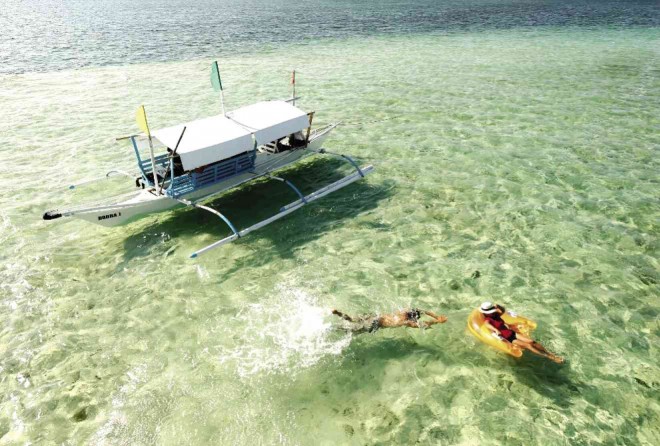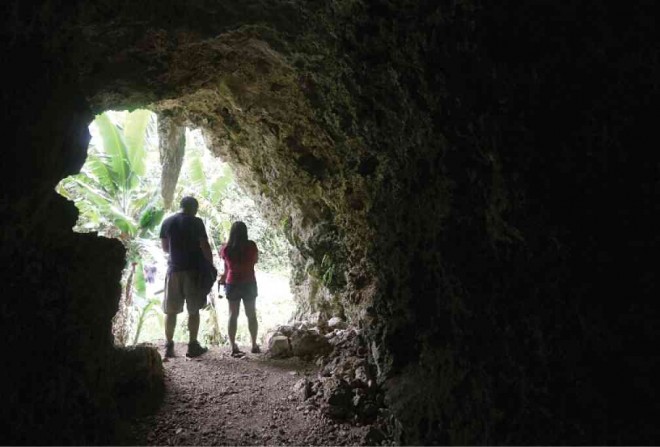Pinamungajan: Escape from Cebu City

CRYSTAL-CLEAR water surrounding the Campalabo Islet in Pinamungajan town TONEE DESPOJO/CEBU DAILY NEWS
Utter the word getaway and immediately, those who have been to the place would think of Pinamungajan town in the province of Cebu.
It offers an escape from the hustle and bustle of the city of Cebu and it does so with its many faces—as a beach resort, a forest hideaway and a family-oriented fun hub.
As a beach resort, Pinamungajan puts forth an islet surrounded by clear blue waters that would be perfect for swimming or bathing in the sun on its white sand beach.
Move a little further inland and discover the waterfalls of Barangay Sacsac.
Bring the kids along and discover the wonders that technology brings through the town’s wave pool.
Stray a little from modern day amenities and enter the dark but cool cavities of a cave in Barangay Sacsac.
Accommodation is not a problem in Pinamungajan.
Facilities
While it has hotel rooms, the town also offers a site for “glamping,” or glamour camping, where tourists can set up tents with beds and electric fans.
Pinamungajan is a second class municipality (annual income of P45 million to P55 million) located 64.8 kilometers west of Cebu City.
The town can be reached by a two-hour bus ride from the Cebu South Bus Terminal in Cebu City for a fare of P80 per person.
Vans could be rented, too, at the One Citilink Terminal in Cebu City, for P100 per person.
Yogi Ygay, the town’s tourism officer, said the ideal time to visit the Campalabo Islet in Pinamungajan is in the early morning.
It is during this time, he said, when low tide occurs and during which the sandbar is most visible. During high tide, the sandbar disappears in knee- to waist-deep waters.
To reach Campalabo Islet, motorcycles are for hire at the town hall in Barangay Poblacion. These can take visitors to Barangay Tajao, where Campalabo is, about 5.5 km from Poblacion.
From Tajao, pump boats can take tourists on a 20-minute ride to the islet where the clear blue waters are so inviting one can’t wait to jump in and the fine, white sand appears so smooth one can’t wait to walk on it.
Volunteer watchmen
One need not wonder long how the islet is kept pristine despite a growing number of visitors descending on it. Built on a portion of the islet is a concrete shed that houses a team of Bantay Dagat, a group of volunteers who keep watch over the marine sanctuary that is marked by white buoys.
Tourists can end the day in Tajao’s white sand beach—at least a kilometer long and mostly publicly owned—and watch the horizon change colors as the sun sets.
If they wish to stay overnight, Borra Beach Resort has four air-conditioned rooms that can each accommodate a group of four tourists at P1,500 per night.
For the more adventurous, the town’s waterfalls and cave in Barangay Sacsac beckon.
The most challenging among the town’s waterfalls is Liki Falls due to its barely used trails, said Ygay.
To get to Liki Falls, one has to walk for 5 kilometers from the town hall to Barangay Sacsac. Visitors would have to cross a river, climb over boulders and walk through bushes and forest shrubs.
Liki Falls consists of three layers of small waterfalls. Its name was derived from the crack (which is liki in Cebuano) in the mountains of Sacsac where spring water gushes out.
On the way back, tourists can pass by a cave near the main road.
The cave is called Pandong Bato, which loosely means shelter made of rock because it used to provide shelter to passersby.
From the outside, the cave has a creepy appearance because of two stalagmite rocks that look like oversized fangs ominously hanging by the entrance.
Tourists would need a spelunker to guide them through the cave.
Smaller stalagmites are visible on the cave’s ceiling. Birds’ nests are also visible on walls near the entrance of the cave.
Family affair
A family outing with children could be best spent in the wave pool at the Hidden Valley Mountain Resort in Barangay Lamac.
The wave pool, which started operations on Dec. 18, 2014, is open from
8 a.m. to 10 p.m. Entrance fee is P100 per person and cottage rentals range from P500 to P800 depending on the size.
Ellen Limocon, general manager of Lamac Multipurpose Cooperative that operates the wave pool, said the cooperative allows guests to rent chairs and tables if cottages are full.
“We are full especially during weekends because people are curious about the first wave pool in the Visayas,” Limocon said.
Expect a bumpy ride going to the wave pool, though, because the concreting of the 14-km road leading to the Hidden Valley Mountain Resort from the town hall has yet to be completed.
The trip is worth it, however. Riding on waves created by air blowers powered by a generator makes up for the hassle of the road trip.
Limocon said the machine generates waves for 30 minutes for smaller crowds and 20 minutes for bigger crowds.

THE VILLAGE of Sacsac in Pinamungajan town offers a trek through this cave. TONEE DESPOJO/CEBU DAILY NEWS
The wave pool, which measures
1,800 square meters, can accommodate 700 to 800 persons. A corner of the pool has been decorated to look like a mountain from where raging water gushes.
Limocon said operators refer to the rest of the pool area as the “ocean” where the waves eventually recede.
Hidden Valley Resort has nine rooms for bed and breakfast accommodations at P3,000 each for an overnight stay.
If tourists want to spend the night under the stars, then “glamping” is a good option.
Glamping is offered inside the 5-hectare Monteray Farm, about a kilometer away from the town hall.
Wilson Balmaceda, who helps run the farm, said a glamping tent can accommodate five persons for P1,000 per day.
But guests don’t have to sleep on damp soil since the tent has a bed and an electric fan inside.
Balmaceda said the farm also allows campers to bring their own tents to the campsite, which has three toilets made of bamboo “to really give our guests an outdoor feel.”
Monteray’s camping grounds are surrounded by native pine trees and madre de cacao.
Located close to the camping ground is a 15-meter zipline that is available for P75 per use. There is also a 5.5-meter deep pool and a mini pool.
Entrance fee is P20 per head while cottage rentals range from P200 to P350.
The farm also offers bungalow-type houses for rent for those who don’t like sleeping inside tents. The rent ranges from P1,800 to P4,000 per day.
Monteray Farm started as a retirement place for couple Ramon and Teresina “Teray” Pono.
Now, the farm is planted to organic herbs and vegetables, said Balmaceda, Pono’s son-in-law.
He has a small nursery and maintains two beds for his vermi composts.
Close to the nursery is a piggery. Aside from pigs, the farm also raises native chickens and ducks.